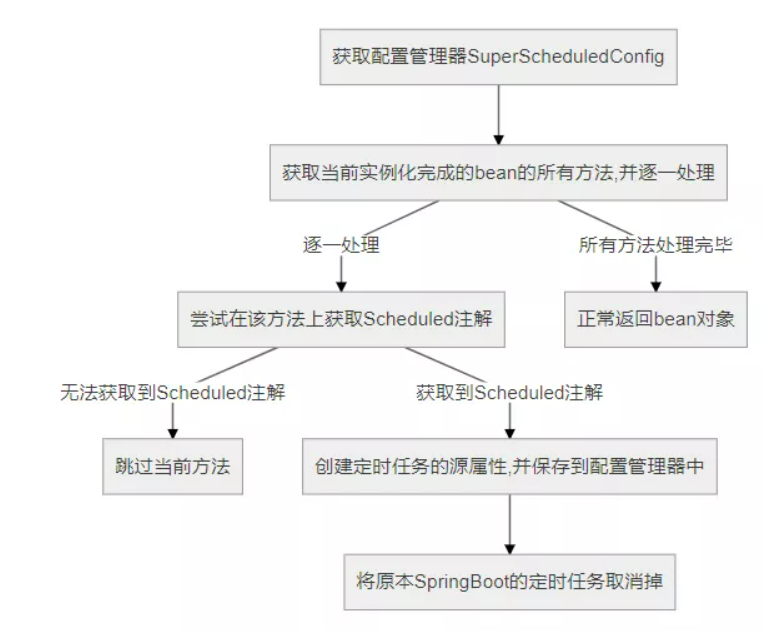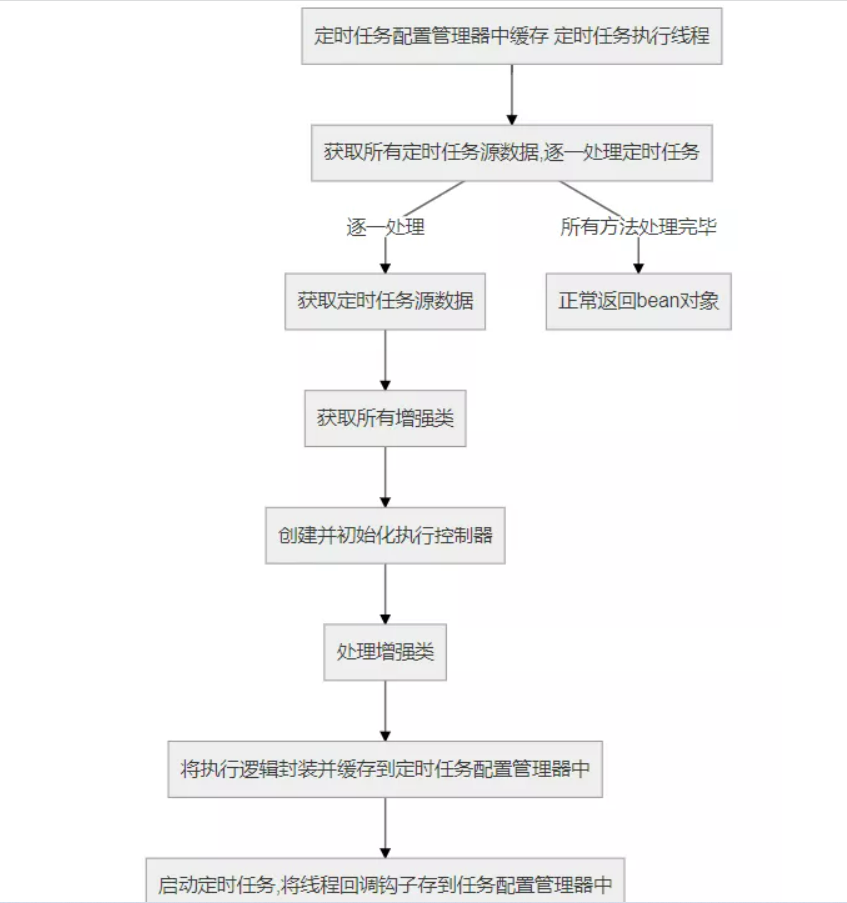一、功能说明
SpringBoot 的定时任务的加强工具,java培训实现对 SpringBoot 原生的定时任务进行动态管理,完全兼容原生 @Scheduled 注解,无需对原本的定时任务进行修改
二、快速使用
具体的功能已经封装成 SpringBoot-starter 即插即用
<dependency> <groupId>com.github.guoyixing</groupId> <artifactId>spring-boot-starter-super-scheduled</artifactId> <version>0.3.1</version></dependency>
复制代码
三、实现原理
1、动态管理实现
(1) 配置管理介绍
@Component("superScheduledConfig")public class SuperScheduledConfig {/*** 执行定时任务的线程池*/private ThreadPoolTaskScheduler taskScheduler;
/** * 定时任务名称与定时任务回调钩子 的关联关系容器 */private Map<String, ScheduledFuture> nameToScheduledFuture = new ConcurrentHashMap<>();
/** * 定时任务名称与定时任务需要执行的逻辑 的关联关系容器 */private Map<String, Runnable> nameToRunnable = new ConcurrentHashMap<>();
/** * 定时任务名称与定时任务的源信息 的关联关系容器 */private Map<String, ScheduledSource> nameToScheduledSource = new ConcurrentHashMap<>();
复制代码
/* 普通的 get/sets 省略 */}
(2) 使用后处理器拦截 SpringBoot 原本的定时任务
实现 ApplicationContextAware 接口拿到 SpringBoot 的上下文
实现 BeanPostProcessor 接口,将这个类标记为后处理器,后处理器会在每个 bean 实例化之后执行
使用 @DependsOn 注解强制依赖 SuperScheduledConfig 类,让 SpringBoot 实例化 SuperScheduledPostProcessor 类之前先实例化 SuperScheduledConfig 类
主要实现逻辑在 postProcessAfterInitialization()方法中
@DependsOn({"superScheduledConfig"})@Component@Orderpublic class SuperScheduledPostProcessor implements BeanPostProcessor, ApplicationContextAware {protected final Log logger = LogFactory.getLog(getClass());
private ApplicationContext applicationContext;
/** * 实例化bean之前的操作 * @param bean bean实例 * @param beanName bean的Name */@Overridepublic Object postProcessBeforeInitialization(Object bean, String beanName) throws BeansException { return bean;}
/** * 实例化bean之后的操作 * @param bean bean实例 * @param beanName bean的Name */@Overridepublic Object postProcessAfterInitialization(Object bean, String beanName) throws BeansException { //1.获取配置管理器 SuperScheduledConfig superScheduledConfig = applicationContext.getBean(SuperScheduledConfig.class);
//2.获取当前实例化完成的bean的所有方法 Method[] methods = bean.getClass().getDeclaredMethods(); //循环处理对每个方法逐一处理 if (methods.length > 0) { for (Method method : methods) { //3.尝试在该方法上获取@Scheduled注解(SpringBoot的定时任务注解) Scheduled annotation = method.getAnnotation(Scheduled.class); //如果无法获取到@Scheduled注解,就跳过这个方法 if (annotation == null) { continue; } //4.创建定时任务的源属性 //创建定时任务的源属性(用来记录定时任务的配置,初始化的时候记录的是注解上原本的属性) ScheduledSource scheduledSource = new ScheduledSource(annotation, method, bean); //对注解上获取到源属性中的属性进行检测 if (!scheduledSource.check()) { throw new SuperScheduledException("在" + beanName + "Bean中" + method.getName() + "方法的注解参数错误"); } //生成定时任务的名称(id),使用beanName+“.”+方法名 String name = beanName + "." + method.getName(); //将以key-value的形式,将源数据存入配置管理器中,key:定时任务的名称 value:源数据 superScheduledConfig.addScheduledSource(name, scheduledSource); try { //5.将原本SpringBoot的定时任务取消掉 clearOriginalScheduled(annotation); } catch (Exception e) { throw new SuperScheduledException("在关闭原始方法" + beanName + method.getName() + "时出现错误"); } } } //最后bean保持原有返回 return bean;}
/** * 修改注解原先的属性 * @param annotation 注解实例对象 * @throws Exception */private void clearOriginalScheduled(Scheduled annotation) throws Exception { changeAnnotationValue(annotation, "cron", Scheduled.CRON_DISABLED); changeAnnotationValue(annotation, "fixedDelay", -1L); changeAnnotationValue(annotation, "fixedDelayString", ""); changeAnnotationValue(annotation, "fixedRate", -1L); changeAnnotationValue(annotation, "fixedRateString", ""); changeAnnotationValue(annotation, "initialDelay", -1L); changeAnnotationValue(annotation, "initialDelayString", "");}
/** * 获取SpringBoot的上下文 * @param applicationContext SpringBoot的上下文 */@Overridepublic void setApplicationContext(ApplicationContext applicationContext) throws BeansException { this.applicationContext = applicationContext;}
复制代码
}
(3) 使用 ApplicationRunner 初始化自定义的定时任务运行器
实现 ApplicationContextAware 接口拿到 SpringBoot 的上下文
使用 @DependsOn 注解强制依赖 threadPoolTaskScheduler 类
实现 ApplicationRunner 接口,在所有 bean 初始化结束之后,运行自定义逻辑
主要实现逻辑在 run()方法中
@DependsOn("threadPoolTaskScheduler")@Componentpublic class SuperScheduledApplicationRunner implements ApplicationRunner, ApplicationContextAware {protected final Log logger = LogFactory.getLog(getClass());private DateTimeFormatter df = DateTimeFormatter.ofPattern("yyyy-MM-dd HH:mm:ss");private ApplicationContext applicationContext;
/*** 定时任务配置管理器/@Autowiredprivate SuperScheduledConfig superScheduledConfig;/** 定时任务执行线程*/@Autowiredprivate ThreadPoolTaskScheduler threadPoolTaskScheduler;
@Overridepublic void run(ApplicationArguments args) { //1.定时任务配置管理器中缓存 定时任务执行线程 superScheduledConfig.setTaskScheduler(threadPoolTaskScheduler); //2.获取所有定时任务源数据 Map<String, ScheduledSource> nameToScheduledSource = superScheduledConfig.getNameToScheduledSource(); //逐一处理定时任务 for (String name : nameToScheduledSource.keySet()) { //3.获取定时任务源数据 ScheduledSource scheduledSource = nameToScheduledSource.get(name); //4.获取所有增强类 String[] baseStrengthenBeanNames = applicationContext.getBeanNamesForType(BaseStrengthen.class); //5.创建执行控制器 SuperScheduledRunnable runnable = new SuperScheduledRunnable(); //配置执行控制器 runnable.setMethod(scheduledSource.getMethod()); runnable.setBean(scheduledSource.getBean()); //6.逐一处理增强类(增强器实现原理后面具体分析) List<Point> points = new ArrayList<>(baseStrengthenBeanNames.length); for (String baseStrengthenBeanName : baseStrengthenBeanNames) { //7.将增强器代理成point Object baseStrengthenBean = applicationContext.getBean(baseStrengthenBeanName); //创建代理 Point proxy = ProxyUtils.getInstance(Point.class, new RunnableBaseInterceptor(baseStrengthenBean, runnable)); proxy.setSuperScheduledName(name); //8.所有的points连成起来 points.add(proxy); }
复制代码
//将 point 形成调用链 runnable.setChain(new Chain(points));//将执行逻辑封装并缓存到定时任务配置管理器中 superScheduledConfig.addRunnable(name, runnable::invoke);try {//8.启动定时任务 ScheduledFuture<?> schedule = ScheduledFutureFactory.create(threadPoolTaskScheduler, scheduledSource, runnable::invoke);//将线程回调钩子存到任务配置管理器中 superScheduledConfig.addScheduledFuture(name, schedule);logger.info(df.format(LocalDateTime.now()) + "任务" + name + "已经启动...");
} catch (Exception e) { throw new SuperScheduledException("任务" + name + "启动失败,错误信息:" + e.getLocalizedMessage()); } }}
@Overridepublic void setApplicationContext(ApplicationContext applicationContext) throws BeansException { this.applicationContext = applicationContext;}
复制代码
}
(4) 进行动态管理
@Componentpublic class SuperScheduledManager {protected final Log logger = LogFactory.getLog(getClass());private DateTimeFormatter df = DateTimeFormatter.ofPattern("yyyy-MM-dd HH:mm:ss");
@Autowiredprivate SuperScheduledConfig superScheduledConfig;
/** * 修改Scheduled的执行周期 * * @param name scheduled的名称 * @param cron cron表达式 */public void setScheduledCron(String name, String cron) { //终止原先的任务 cancelScheduled(name); //创建新的任务 ScheduledSource scheduledSource = superScheduledConfig.getScheduledSource(name); scheduledSource.clear(); scheduledSource.setCron(cron); addScheduled(name, scheduledSource);}
/** * 修改Scheduled的fixedDelay * * @param name scheduled的名称 * @param fixedDelay 上一次执行完毕时间点之后多长时间再执行 */public void setScheduledFixedDelay(String name, Long fixedDelay) { //终止原先的任务 cancelScheduled(name); //创建新的任务 ScheduledSource scheduledSource = superScheduledConfig.getScheduledSource(name); scheduledSource.clear(); scheduledSource.setFixedDelay(fixedDelay); addScheduled(name, scheduledSource);}
/** * 修改Scheduled的fixedRate * * @param name scheduled的名称 * @param fixedRate 上一次开始执行之后多长时间再执行 */public void setScheduledFixedRate(String name, Long fixedRate) { //终止原先的任务 cancelScheduled(name); //创建新的任务 ScheduledSource scheduledSource = superScheduledConfig.getScheduledSource(name); scheduledSource.clear(); scheduledSource.setFixedRate(fixedRate); addScheduled(name, scheduledSource);}
/** * 查询所有启动的Scheduled */public List<String> getRunScheduledName() { Set<String> names = superScheduledConfig.getNameToScheduledFuture().keySet(); return new ArrayList<>(names);}
/** * 查询所有的Scheduled */public List<String> getAllSuperScheduledName() { Set<String> names = superScheduledConfig.getNameToRunnable().keySet(); return new ArrayList<>(names);}
/** * 终止Scheduled * * @param name scheduled的名称 */public void cancelScheduled(String name) { ScheduledFuture scheduledFuture = superScheduledConfig.getScheduledFuture(name); scheduledFuture.cancel(true); superScheduledConfig.removeScheduledFuture(name); logger.info(df.format(LocalDateTime.now()) + "任务" + name + "已经终止...");}
/** * 启动Scheduled * * @param name scheduled的名称 * @param scheduledSource 定时任务的源信息 */public void addScheduled(String name, ScheduledSource scheduledSource) { if (getRunScheduledName().contains(name)) { throw new SuperScheduledException("定时任务" + name + "已经被启动过了"); } if (!scheduledSource.check()) { throw new SuperScheduledException("定时任务" + name + "源数据内容错误"); }
scheduledSource.refreshType();
Runnable runnable = superScheduledConfig.getRunnable(name); ThreadPoolTaskScheduler taskScheduler = superScheduledConfig.getTaskScheduler();
ScheduledFuture<?> schedule = ScheduledFutureFactory.create(taskScheduler, scheduledSource, runnable); logger.info(df.format(LocalDateTime.now()) + "任务" + name + "已经启动...");
superScheduledConfig.addScheduledSource(name, scheduledSource); superScheduledConfig.addScheduledFuture(name, schedule);}
/** * 以cron类型启动Scheduled * * @param name scheduled的名称 * @param cron cron表达式 */public void addCronScheduled(String name, String cron) { ScheduledSource scheduledSource = new ScheduledSource(); scheduledSource.setCron(cron);
addScheduled(name, scheduledSource);}
/** * 以fixedDelay类型启动Scheduled * * @param name scheduled的名称 * @param fixedDelay 上一次执行完毕时间点之后多长时间再执行 * @param initialDelay 第一次执行的延迟时间 */public void addFixedDelayScheduled(String name, Long fixedDelay, Long... initialDelay) { ScheduledSource scheduledSource = new ScheduledSource(); scheduledSource.setFixedDelay(fixedDelay); if (initialDelay != null && initialDelay.length == 1) { scheduledSource.setInitialDelay(initialDelay[0]); } else if (initialDelay != null && initialDelay.length > 1) { throw new SuperScheduledException("第一次执行的延迟时间只能传入一个参数"); }
addScheduled(name, scheduledSource);}
/** * 以fixedRate类型启动Scheduled * * @param name scheduled的名称 * @param fixedRate 上一次开始执行之后多长时间再执行 * @param initialDelay 第一次执行的延迟时间 */public void addFixedRateScheduled(String name, Long fixedRate, Long... initialDelay) { ScheduledSource scheduledSource = new ScheduledSource(); scheduledSource.setFixedRate(fixedRate); if (initialDelay != null && initialDelay.length == 1) { scheduledSource.setInitialDelay(initialDelay[0]); } else if (initialDelay != null && initialDelay.length > 1) { throw new SuperScheduledException("第一次执行的延迟时间只能传入一个参数"); }
addScheduled(name, scheduledSource);}
/** * 手动执行一次任务 * * @param name scheduled的名称 */public void runScheduled(String name) { Runnable runnable = superScheduledConfig.getRunnable(name); runnable.run();}
复制代码
}
2、增强接口实现
增强器实现的整体思路与 SpringAop 的思路一致,实现没有 Aop 复杂
(1) 增强接口
@Order(Ordered.HIGHEST_PRECEDENCE)public interface BaseStrengthen {/*** 前置强化方法** @param bean bean 实例(或者是被代理的 bean)* @param method 执行的方法对象* @param args 方法参数*/void before(Object bean, Method method, Object[] args);
/** * 后置强化方法 * 出现异常不会执行 * 如果未出现异常,在afterFinally方法之后执行 * * @param bean bean实例(或者是被代理的bean) * @param method 执行的方法对象 * @param args 方法参数 */void after(Object bean, Method method, Object[] args);
/** * 异常强化方法 * * @param bean bean实例(或者是被代理的bean) * @param method 执行的方法对象 * @param args 方法参数 */void exception(Object bean, Method method, Object[] args);
/** * Finally强化方法,出现异常也会执行 * * @param bean bean实例(或者是被代理的bean) * @param method 执行的方法对象 * @param args 方法参数 */void afterFinally(Object bean, Method method, Object[] args);
复制代码
}
(2) 代理抽象类
public abstract class Point {/*** 定时任务名*/private String superScheduledName;
/** * 抽象的执行方法,使用代理实现 * @param runnable 定时任务执行器 */public abstract Object invoke(SuperScheduledRunnable runnable);
/* 普通的get/sets省略 */
复制代码
}
(3) 调用链类
public class Chain {private List<Point> list;private int index = -1;/*** 索引自增 1*/public int incIndex() {return ++index;}
/** * 索引还原 */public void resetIndex() { this.index = -1;}
复制代码
}
(4) cglib 动态代理实现
使用 cglib 代理增强器,将增强器全部代理成调用链节点 Point
public class RunnableBaseInterceptor implements MethodInterceptor {/*** 定时任务执行器/private SuperScheduledRunnable runnable;/** 定时任务增强类*/private BaseStrengthen strengthen;
@Overridepublic Object intercept(Object obj, Method method, Object[] args, MethodProxy methodProxy) throws Throwable { Object result; //如果执行的是invoke()方法 if ("invoke".equals(method.getName())) { //前置强化方法 strengthen.before(obj, method, args); try { //调用执行器中的invoke()方法 result = runnable.invoke(); } catch (Exception e) { //异常强化方法 strengthen.exception(obj, method, args); throw new SuperScheduledException(strengthen.getClass() + "中强化执行时发生错误", e); } finally { //Finally强化方法,出现异常也会执行 strengthen.afterFinally(obj, method, args); } //后置强化方法 strengthen.after(obj, method, args);
} else { //直接执行方法 result = methodProxy.invokeSuper(obj, args); } return result;}
public RunnableBaseInterceptor(Object object, SuperScheduledRunnable runnable) { this.runnable = runnable; if (BaseStrengthen.class.isAssignableFrom(object.getClass())) { this.strengthen = (BaseStrengthen) object; } else { throw new SuperScheduledException(object.getClass() + "对象不是BaseStrengthen类型"); }}
public RunnableBaseInterceptor() {
}
复制代码
}
(5) 定时任务执行器实现
public class SuperScheduledRunnable {/*** 原始的方法/private Method method;/** 方法所在的 bean/private Object bean;/** 增强器的调用链*/private Chain chain;
public Object invoke() { Object result; //索引自增1 if (chain.incIndex() == chain.getList().size()) { //调用链中的增强方法已经全部执行结束 try { //调用链索引初始化 chain.resetIndex(); //增强器全部执行完毕,执行原本的方法 result = method.invoke(bean); } catch (IllegalAccessException | InvocationTargetException e) { throw new SuperScheduledException(e.getLocalizedMessage()); } } else { //获取被代理后的方法增强器 Point point = chain.getList().get(chain.getIndex()); //执行增强器代理 //增强器代理中,会回调方法执行器,形成调用链,逐一运行调用链中的增强器 result = point.invoke(this); } return result;}
/* 普通的get/sets省略 */
复制代码
}
(6) 增强器代理逻辑
com.gyx.superscheduled.core.SuperScheduledApplicationRunner 类中的代码片段
//创建执行控制器SuperScheduledRunnable runnable = new SuperScheduledRunnable();runnable.setMethod(scheduledSource.getMethod());runnable.setBean(scheduledSource.getBean());//用来存放 增强器的代理对象List<Point> points = new ArrayList<>(baseStrengthenBeanNames.length);//循环所有的增强器的beanNamefor (String baseStrengthenBeanName : baseStrengthenBeanNames) { //获取增强器的bean对象 Object baseStrengthenBean = applicationContext.getBean(baseStrengthenBeanName); //将增强器代理成Point节点 Point proxy = ProxyUtils.getInstance(Point.class, new RunnableBaseInterceptor(baseStrengthenBean, runnable)); proxy.setSuperScheduledName(name); //增强器的代理对象缓存到list中 points.add(proxy);}//将增强器代理实例的集合生成调用链//执行控制器中设置调用链runnable.setChain(new Chain(points));
复制代码
来源 Java 笔记虾














评论